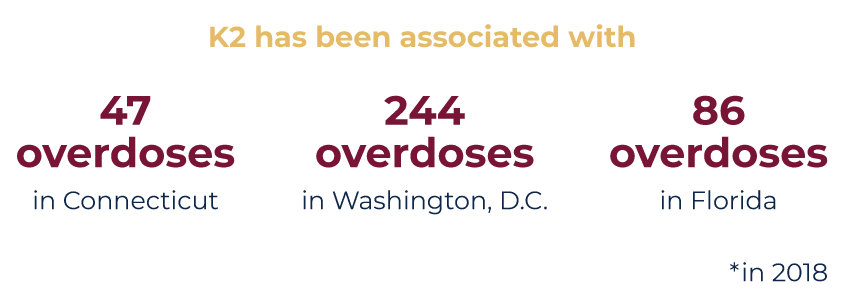K2 (Spice) - Synthetic Marijuana

K2 (Spice) - Synthetic Marijuana
Table of Contents
Introduction
There’s a misconception that synthetic cannabinoids, also known as synthetic marijuana, K2, and Spice, are safer than natural marijuana. However, they are a toxic cocktail of lethal chemicals with severe health and safety risks. K2 can create addiction with a need for treatment in a rehab center.
The Centers for Disease Control and Prevention (CDC) reported that the number of deaths from synthetic cannabinoids nearly tripled between 2014 and 2015. During the 2015 study period, poison centers got 3,572 calls associated with synthetic cannabinoid use.
What Is Synthetic Marijuana?
K2 or Spice is a synthetic cannabis drug that consists of a mixture of materials that have been enhanced with mind-altering chemicals. It’s a designer drug with a diverse chemical structure that’s abused to obtain a high that some say feel similar to using marijuana. The synthetic mind-altering chemicals may also be sold as liquids to be inhaled in e-cigarettes.1
Although it’s often claimed that synthetic cannabinoid products contain natural ingredients from plants, the only natural part is the dried plant materials, sometimes- not even that. Some manufacturers use artificial materials as a base for K2. Several chemical tests have shown that the mind-altering ingredients sprayed on the plants are made in laboratories. In 2014, there were over 150 synthetic cannabinoids known to scientists, and the list is continually growing.
In 2015 alone, the National Forensic Laboratory Information System identified 84 new synthetic cannabinoids.
It Was Created by Scientists at Clemson University
K2 was initially made in a laboratory by scientists from Clemson University and a researcher called John W. Huffman. They were looking to create a drug that could enhance the medicinal properties of THC while eliminating its psychotropic effects. Soon after Huffman and his colleagues published their findings in academic literature, drug manufacturers began selling synthetic cannabinoids on the market. The first synthetic compound that appeared on the street was known as K2. The main chemical was called JWH-18, named after John W. Huffman.
More About Other Drugs
How Is It Different from Marijuana?
Many people have used synthetic cannabinoids as an alternative to marijuana since 2002. Spice/K2 is also called synthetic marijuana or “fake weed” because the chemicals it contains are similar to the chemicals present in the marijuana plant. The drug is also marketed as a safe and legal alternative to marijuana. However, it’s far from safe; it can impact the human brain more powerfully than marijuana. The side effects can be unpredictable and, in some cases, even life-threatening.
However, marijuana has been proven to have medical benefits. Many states in the U.S., and many countries around the world, have legalized it for medical and recreational purposes. A large number of chemicals that are sprayed on synthetic weed are illegal and haven’t been proven to have beneficial properties. The danger of K2 is in its human-made compounds that haven’t been thoroughly researched. Researchers believe that synthetic cannabinoids can be up to 100 times more potent than THC.
Street Names of Synthetic Marijuana
Spice products are sold in colorful foil packages to attract consumers’ attention. They contain 1-3 g of dried matter (leaves, flowers, resin) to which one or more synthetic cannabinoids have been added. As manufacturers try to stay ahead of authorities, they continually change the chemicals added to the product to circumvent the law.
The products are sold under a range of different street names, including:
K2
Spice
Joker
Kush
Kronic
Blaze
Magma
Ninja
Nitro
Puff
Genie
Ultra Chronic
Many of them circulate under exotic names such as:
Bombay Blue
Experience-Chill
Ice Bud Extra Cold
Herbal Dream
Red Magic
Spice Gold Spirit
Spice Tropical Synergy
Yucatan Fire
How Do People Use K2?
The most common way of using fake weed is by smoking the dried plant materials in a cigarette. Some people also mix the drug with real marijuana or brew it as tea. It’s not uncommon for people to buy it as a liquid to vaporize in e-cigarettes.
Is K2 Safe?
As marijuana is becoming legal around the world, people mistakenly think that all products that are branded as marijuana are safe.
However, K2 is more potent than medical marijuana. Although research is limited, researchers know that synthetic cannabinoids act on the same brain cell receptors as THC (delta-9-tetrahydrocannabinol).2 Their findings have also shown that some of the chemicals found in Spice tend to bind more strongly than marijuana to the same receptors to which THC and CBD attach. Consequently, they can produce more potent and sometimes dangerous side effects.
Synthetic cannabinoids can be more dangerous when:
There is the presence of a mental health problem (the drug can intensify the symptoms of anxiety and paranoia)
An existing heart problem is present
Taken in combination with alcohol or other drugs
Driving or operating heavy machinery occurs after taking them
What makes the drug risky is that no one can ever be sure what they are taking. The active chemicals are always changing so that manufacturers can avoid the law. Different batches can vary in chemical compounds and strength. Consequently, it’s easy for people to take a higher-than-intended amount, or to take an unfamiliar substance under a familiar name.
What Does K2 Contain?
According to the Designer Drug Research Unit of the National Institute on Drug Abuse’s (NIDA’s) Intramural Research Program, it’s hard to know precisely what is in K2.
At this time, hundreds of synthetic cannabinoids have been detected. As the drugs are manufactured in illegal laboratories, the chemicals can vary from batch to batch. The health risks are even higher because the products are not inspected for quality.
Those who have tried synthetic cannabinoids say that their effects are similar to those produced by marijuana, such as:
Elevated mood
Relaxation
Awareness of surrounding objects and conditions
Delusional or disordered thinking
Is It Addictive?
Even though K2 is marketed as a safe alternative to marijuana, NIDA states otherwise. According to them, the drug can be addictive.
Scientists have been trying to determine the effects of K2 by studying THC. In their view, long-term use of these drugs can lead to tolerance and dependence. The person abusing the drug will require larger doses of the substance to experience the same high. People who have abused the substance for a long time and who have tried to quit taking the drug have experienced a range of withdrawal symptoms, including:
Headaches
Anxiety
Irritability
Depression
Side Effects
Synthetic cannabis is a relatively new drug. There’s limited information available about its short- and long-term effects. But it’s been reported to have some side effects similar to cannabis, along with with some additional negative and more harmful side effects, including:
Anxiety
Agitation
Irritability
Confusion
Concentration issues
Hallucinations
Sleepiness
Dizziness
Delusions
Psychosis
Suicidal thoughts
Violent behavior
Stroke
Seizures
However, as the ingredients in the batches rapidly change, people who consume them can never know for sure what set of side effects they will experience. Moreover, two different people can consume the same batch but still develop different symptoms. The symptoms may depend on their predisposition to particular illnesses, as well as on any genetic susceptibilities they may have.
Factors That Effect Side Effects
The weight and size of the person
The amount taken
How often it was taken
Whether other drugs were taken at the same time
The nature and potency of the specific chemicals that the drug contains
Lack of Long-Term Studies
Researchers still haven’t identified the long-term side effects of K2. However, it’s believed that long-term marijuana use can negatively affect the development of the brain and lead to issues with thinking, learning, and memory. Considering that K2 is more potent than THC, researchers believe its long-term effects will be identical to or stronger than those of THC.
Overdose
People who abuse Spice expose their brains to unidentified chemicals that haven’t been tested on humans.
As the drug can have a diverse structure, it’s difficult to know what exactly the person is buying. Consequently, it’s possible to experience a range of possible side effects, including overdose.
People have died from K2 overdoses, but it’s hard to know what amount of the drug, or what combination of chemicals, is deadly.

According to the U.S. Drug Enforcement Administration (DEA), the drug has been associated with more than 47 overdoses in Connecticut and 244 overdoses in Washington, D.C. In Florida, it claimed the lives of 86 people in 2018.
Deaths/E.R. Visits
Using synthetic cannabinoids is a risky and unpredictable experience. In New York City alone, there were more than 6,000 ER visits and two deaths involving the drug in 2015.
Between 2011 and 2017, the U.S. poison control centers got more than 31,000 calls associated with K2 effects.
The CDC reported that the number of deaths from synthetic cannabinoids nearly tripled between 2014 and 2015. During the 2015 study period, poison centers got 3,572 calls associated with synthetic cannabinoid use. Compared to the same study period in 2014, when they received 1,085 calls, this was a 229% increase. The most common negative health effects reported were:3
The risk of K2 deaths and E.R. visits is due to the lack of manufacturing standards. In addition to the lack of quality control, K2 products are often laced with other toxic substances. Some of the drugs found in the state of Illinois were mixed with brodifacoum, a chemical found in rat poison.
Is It Legal?
When synthetic cannabinoids first appeared, they were added to all kinds of products. Around 2004, they became available on the Internet and in specialized shops. They were sold as meditation potpourris, bath additives, air fresheners, or tropical car perfumes.
Although the ingredients of the products weren’t illegal at the time, in 2008, it was confirmed that the products contained two synthetic psychoactive compounds: the cyclohexylphenol C.P. 47,497-C8 and the aminoalkylindole JWH-018.
By 2010 some states in the U.S. passed laws that banned the sale of synthetic cannabinoids. In 2012 President Obama signed the Synthetic Drug Abuse Prevention Act, which classified the active ingredients in synthetic cannabinoids as Schedule I drugs.
How Many People Use K2/Spice?
According to a 2011 survey by NIDA, Spice was the second most widely used illicit drug among high school seniors.4
An anonymous online survey conducted in 2011 with 14,966 participants from different countries in the world found that 17% of those surveyed had used synthetic cannabis. Of those, 41% reported having used in the last 12 months. Around 93% of the respondents said they preferred natural cannabis to synthetic cannabis due to the greater pleasurable effects of the high it induced.5
A large number of people who use synthetic cannabinoids are in their 20s and 30s, with men being more likely to use the drug than women.6
Reasons for the popularity of fake weed include its affordability and easy access, the fact that standard drug tests cannot easily detect many of the chemicals used in this product, and the common false belief that K2 is safe to use.
Data from an anonymous online survey in 2011 that was conducted on 168 respondents found that the average number of days of K2 use in the previous year was 67. The average daily number of uses was four. On average, people used 1 g of product per dose, and the maximum amount of drug used in a single episode was 1.5 g.
Can It Be Detected in Drug Tests?
Detecting synthetic cannabinoids may be difficult, as the drugs don’t show up on most standard in-house hospital drug tests. Moreover, only a small number of commercial labs offer tests for synthetic cannabinoids, but even those are limited and may not detect all synthetic cannabinoids.
Presently, there are few comprehensive screening methods for the detection of synthetic marijuana in biological specimens. However, as newer forms of the drug continually appear, some ingredients may not be detected even by urine tests that are designed to cover a wide range of “metabolites.”
Current Regulations
When synthetic cannabinoids first appeared on the market in the mid-2000s, the substances they contained were not illegal. However, by the end of the decade, several states passed laws to ban their sale.
In 2011, the DEA used emergency protocols to temporarily schedule some of the substances found in synthetic cannabinoid products. President Obama signed the Synthetic Drug Abuse Prevention Act in 2012. With the act, several different classes of psychoactive substances, including synthetic cannabinoids, were classified as Schedule I drugs.
Many state and local governments have also passed their own laws targeting other synthetic cannabinoids.
Future Regulations
Manufacturers of synthetic cannabinoids, in an attempt to avoid the new laws and regulations, consistently create new products with different ingredients. Every time authorities ban a chemical compound, the formula is changed, and a new legal mix can be sold again.
Continued close monitoring of new chemical compounds will be essential. Authorities have also been considering passing a bill to ban all synthetic smoking mixtures.
K2 In the News
LSU Football Scandal, 2014
K2 is popular among high school and college students. In 2011, three Louisiana State University (LSU) football players were suspended from an upcoming game against Auburn. Reportedly, the players were smoking synthetic marijuana, which is a prohibited substance, according to the National Collegiate Athletic Association (NCAA).
One month before the LSU case, a college athlete called Lamar Jack collapsed during a preseason warm-up with his team and died a few days later. The lab tests found that Jack died after ingesting a chemical that is a crucial ingredient in K2. He was 19 years old.
Russia Outbreak, 2014
In the autumn of 2014, synthetic cannabinoids caused an outbreak of mass poisonings in Russia. The cannabinoid MDMB-FUBINACA poisoned more than 1,000 people, of whom 40 died, during a period of a few weeks.
Spice first hit the Kirov region in September 2014, when 150 people were poisoned; four of them died, including a 15-year-old boy. The epidemic soon spread in the Siberian city of Surgut, where it killed six people. It poisoned many more in other regions.
The Russian authorities said that the reason for the outbreak was their inability to keep up with the quickly changing chemical formulas of the designer drugs used in Spice. On October 30, President Putin signed a bill that increased the penalty for selling or consuming smoking blends.
Brooklyn, NY Overdoses, 2016
In 2016, in the area on the border of two developing neighborhoods, Bedford-Stuyvesant and Bushwick, 33 people suspected of overdosing on K2 were taken to hospitals. The people were suffering from “altered mental states,” lethargy, and respiratory issues.
Local residents compared the scene to a scene out of a zombie movie.
The blood and urine samples that were drawn from eight of the 18 men taken to area hospitals that day detected the presence of a synthetic cannabinoid called AMB-FUBINACA that was initially developed by the pharmaceutical company Pfizer.
The growing presence of the drug in people experiencing homelessness caused NYC health officials to declare it a public health crisis in the summer of 2016.
Multiple Outbreaks in the U.S., 2018
In 2018 more than 200 people across nine states in the U.S. reported symptoms related to exposure to synthetic cannabinoids after using a drug suspected to be tainted with K2. The outbreak resulted in the death of five patients.
The presence of brodifacoum, a vitamin K antagonist, and an anticoagulant was detected in almost all of the patients. Most of the patients were from Illinois; the others were from Maryland, Indiana, Florida, Kentucky, Missouri, Pennsylvania, Virginia, and Wisconsin.
All patients reported bleeding from one or more sites. State and national public health officials said that this was the first time they had seen synthetic marijuana cause severe bleeding, a condition that can be deadly if left untreated.
Treatment
Symptoms and Options for Treatment
As noted above, there’s no single formula for K2. Its ingredients can vary, as well as its toxicity and strength. Different batches can affect two people differently, depending on their predisposition, overall health, and other factors such as the amount taken.
Consequently, withdrawal symptoms are unpredictable. Some people report feeling the same symptoms experienced by marijuana, such as nausea, anxiety, aggression, irritability, insomnia, and cravings. Others report vomiting and feeling panicked. Some real-life stories tell of people jumping from windows, having heart attacks, and even setting themselves on fire.
Due to the unpredictability of the withdrawal symptoms and the lack of research about the long-term side effects, it’s recommended that people with an addiction to K2 seek treatment through residential treatment centers, support groups, and individual therapy sessions.
Residential Treatment
Patients in residential treatment centers receive 24/7 support and care. Depending on the type of addiction, a range of activities can occur, including counseling, medication management, 12-step sessions, holistic therapies, and more.
During treatment, patients live on-site and follow a well-structured program that can last for 28 days to a few months, depending on their level of addiction. Under the guidance of an experienced medical staff of doctors, therapists, and nurses, patients address their behavioral, emotional, and mental health needs.
Before entering into residential treatment, patients undergo assessments and screenings to determine the type of care they need to experience long-term recovery. As many individuals with substance abuse disorders are at risk of a co-occurring mental health disorder, patients must be assessed for any signs of mental health issues such as depression or anxiety. Treating the physical symptoms of the addiction without addressing the psychological causes is not a treatment that heals the entire person; such partial treatment often results in relapse.
Moreover, it’s recommended to undergo detox, in which the body will be cleansed of all toxins.
Individual Therapy Sessions
Patients who enter a residential treatment center are usually assigned a professional counselor. They meet with their assigned counselor at least once per week for a session that generally lasts for 45 minutes. The sessions revolve around learning coping skills, managing emotions without using drugs, and building a support group. The patient is guided towards getting rid of damaging behaviors and developing a healthier mindset. According to addiction treatment research, the minimum number of therapy sessions required for lasting results is 16. Professional counselors are well-informed about addiction and have experience working with different individuals. They can help patients obtain recovery safely and securely.
Support Groups
In many cases, joining a support group is an effective way to deal with K2 addiction. Listening to and learning from other people suffering from the same addiction can show that no one is alone and that recovery can happen with the help of others. A support group like Marijuana Anonymous (M.A.) is a great place to start.
Conclusion
The synthetic marijuana drug, also known as “spice” and “K2,” is a smoking mixture made from spraying marijuana-mimicking designer drugs on natural herbs. This potent drug has been notorious among local and federal authorities for causing acute poisonings, overdoses, and even deaths.
The drug can contain many different chemicals, some of which are unknown to authorities and medical personnel. As manufacturers continually create new chemical compounds to evade detection, the risk of side effects is higher.
Although the side effects vary depending on a range of factors, some of the most common include anxiety, hallucinations, delusions, psychosis, suicidal thoughts, violent behavior, and seizures.
People abusing synthetic marijuana have also shown signs of dependence. As the withdrawal symptoms are unpredictable, and people with a history of drug abuse may be suffering from co-occurring disorders, treatment is recommended. The most effective treatment includes residential care, individual therapy sessions, and local support groups.
This information should not replace a visit to a doctor or treatment center. If you are concerned that you or your loved one might be suffering from synthetic marijuana addiction, ask for professional help today.
Resources
- https://academic.oup.com/ijnp/article/17/3/509/760257
- https://www.drugabuse.gov/publications/drugfacts/synthetic-cannabinoids-k2spice
- https://www.cdc.gov/mmwr/preview/mmwrhtml/mm6422a5.htm?s_cid=mm6422a5_w
- https://hscweb3.hsc.usf.edu/blog/2013/11/19/case-studies-by-usf-health-neurologists-link-smoking-spice-with-stroke-in-healthy-young-adults/
- https://www.ncbi.nlm.nih.gov/pubmed/23291209
- https://www.cdc.gov/nceh/hsb/chemicals/sc/healthcare.html















